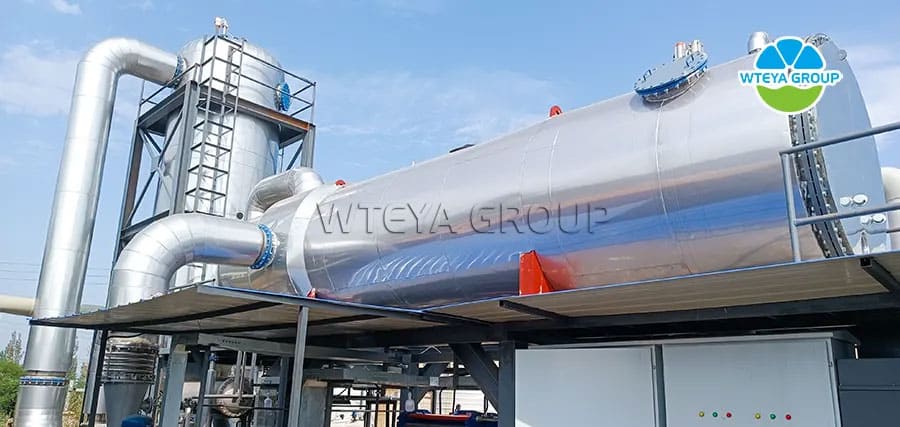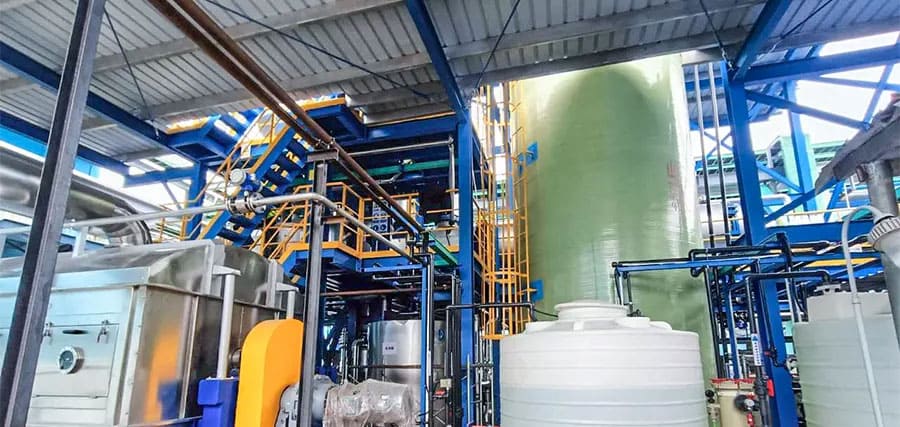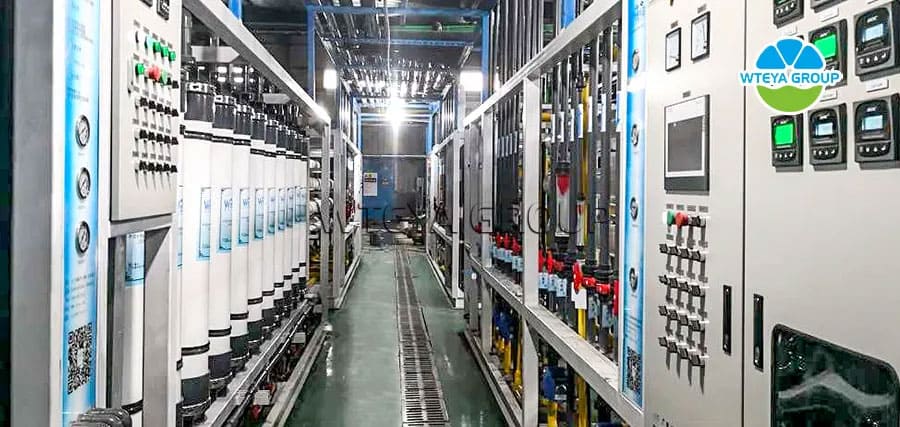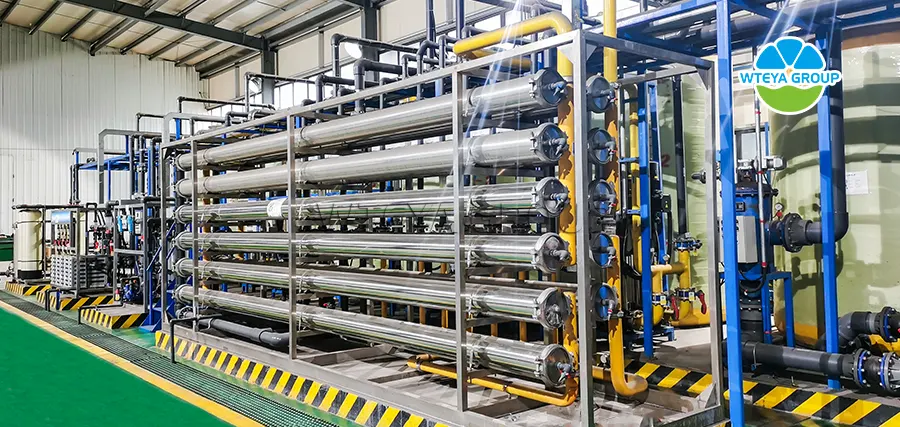Water treatment solutions in food processing industry
1. Evaporative crystal system:
Application in production
Evaporation concentration is one of the key steps in producing white sugar. Through the evaporation process, water and sugar in the syrup can be separated. There are multiple evaporation methods to choose from, such as normal pressure evaporation and vacuum evaporation. The next step is the process of boiling and crystallizing sugar. After washing the sugar water, it undergoes a crystallization process to crystallize sucrose. Both of these keys require precise control of factors such as temperature, pressure, and crystallization time to ensure the quality and yield of crystalline sugars. Through this treatment, high-purity white sugar can be obtained.
Technical Principles
The principle of MVR technology is mainly based on steam compression and energy reuse.
Firstly, the secondary steam compression technology generated by the compressor evaporator increases its temperature and pressure, thereby increasing the thermal expansion of the steam. After compressing high-temperature and high-pressure steam into a heat exchanger for condensation, fully utilize the potential heat of the steam. During this process, the energy of steam is increased and can be reused for heating and evaporation, thereby achieving energy recovery and reuse.
What achievements can we achieve?
The concentration of clean water obtained from Sugar cane juice after treatment is 12 ° BX~14 ° BX (i.e. 86%~88% water). If dilute water containing a large amount of water is directly delivered to the crystallization site, it will consume a large amount of water vapor, which not only consumes energy but also prolongs the time for boiling sugar. Therefore, clean water must undergo an evaporation process to remove a large amount of water and concentrate into a syrup of approximately 60 ° BX before it can crystallize. The MVR evaporation system produced by our company can reduce the moisture content of syrup and also utilize the characteristics of steam compression to save a large amount of steam, thereby reducing the operating costs of the enterprise and improving the economic benefits of the sugar factory.
2. Activated carbon/multimedia filtration system:
Application in production
Media filters are typically used as part of the pre-treatment stage to remove suspended solids and particles from water. It uses multi-layer filtration with different media, which can effectively block solid particles and improve water quality. This filter is very important in beverage production as it ensures that the water quality entering the production process meets standards and prevents impurities from adversely affecting product quality.
Activated carbon filters are mainly used to remove organic matter, odors, and pigments from water. Activated carbon has strong absorption capacity and can absorb various pollutants in water, making the water quality more pure. In beverage production, using activated carbon filters can ensure that the taste and color of the product meet the requirements, and improve the overall quality of the product.
These two types of filters are usually used in combination, first removing large particle impurities through multimedia filters, and then removing organic matter and odor through activated carbon filters to obtain high-quality water sources suitable for beverage production. This processing process can ensure the safety and taste of the beverage, meeting the needs of consumers.
Technical Principles
The technical principle of multimedia filters is mainly to use one or more filtering media to remove suspended impurities in water through deep filtration. When the raw water passes through the filter material from top to bottom, larger particles are removed at the top layer, while smaller particles are removed deeper in the filter medium. This largely depends on the adsorption and mechanical flow resistance of the filter material layer, as well as the degree of tight arrangement of sand particles, which gives water particles more opportunities to collide with and be captured by sand particles. After this treatment, the suspension drainage system can be controlled at a lower level to ensure the clarity of water quality.
The technical principle of activated carbon filters is mainly based on the adsorption effect of activated carbon. Activated carbon has a large surface area and complex pore structure, allowing it to strongly absorb. When water passes through an activated carbon filter, organic matter, odors, pigments, and other pollutants in the water will be absorbed by the surface of the activated carbon, effectively removing them. In addition, activated carbon can also remove residual chlorine from water, ensuring the normal operation of subsequent treatment equipment.
What achievements can we achieve?
The combination of multimedia filters and activated carbon filters can achieve complete purification and upgrading of beverage production water. This not only improves the quality and flavor of beverages, meets consumer needs, but also ensures the safety of beverages and minimizes risks in the production process. Meanwhile, in accordance with the requirements of environmental protection and sustainable development, the use of these two types of filters also helps to minimize the use of chemical agents and wastewater discharge to the greatest extent possible.
Therefore, the application of multimedia filters and activated carbon filters in the beverage industry is of great significance and is a key link in achieving high-quality, safe, and environmentally friendly beverage production.
3. Ultrafiltration system:
Application in production
The application of ultrafiltration technology in the beverage industry is mainly reflected in the process steps of raw material processing and mixing.
In the raw material processing stage, ultrafiltration membrane technology can filter and separate impurities, microorganisms, suspended solids, particles, and glue from the raw materials, thereby improving the purity and taste of beverages. This helps to ensure the quality and safety of beverages while maintaining the nutritional content and flavor of the ingredients.
Technical Principles
The technical principle of ultrafiltration is mainly based on pressure controlled membrane separation process. The core is to use a semi permeable membrane with a specific pore size, called an ultrafiltration membrane, to keep glue, particles, and relatively high molecular weight materials in water, while water and small dissolved particles can pass through the membrane.
The pore size of the ultrafiltration membrane is generally between 20~1000A °, with a filtration range of 0.002 μ m~0.2 μ m, which can effectively block particles with a diameter greater than 0.002 μ m, such as proteins, pectin, fats, and microorganisms. At the same time, small molecules like salts, sugars, and other solutes can pass through the ultrafiltration membrane. This separation effect makes ultrafiltration particularly useful in the beverage industry to remove impurities and microorganisms from raw materials, improving the purity and flavor of beverages.
What achievements can we achieve?
1. Improve product purity: Ultrafiltration technology can effectively remove impurities, suspended solids, glue, and microorganisms from beverages, greatly improving product purity. This helps to ensure the taste and quality of the beverage, and meets the demand of consumers for pure and healthy beverages.
2. Preserving Nutrients: Compared with traditional heat treatment methods, ultrafiltration can retain the nutrients in beverages while removing impurities such as vitamins and minerals. This is particularly important for beverage products that focus on nutritional value.
3. Improving taste: Through ultrafiltration treatment, impurities and unpleasant taste substances in the beverage are eliminated, making the product taste more fresh and pure. This helps to improve the overall quality of beverages and their competitiveness in the market.
4. Extend shelf life: Ultrafiltration technology can reduce the microbial content in beverages, effectively extending the product's shelf life. This helps to reduce quality issues caused by microbial contamination and lower production costs.
5. Improve production efficiency: The ultrafiltration process is relatively simple, fast, and easy to achieve automatic control. This helps to improve beverage production efficiency, reduce production costs, and bring greater economic benefits to the enterprise.
6. Resource recovery: In the beverage production process, ultrafiltration technology can also be used for the recovery and reuse of valuable components in wastewater, achieving resource conservation and environmental protection.
4. RO membrane system:
Application in production
Reverse osmosis technology utilizes the selective transfer ability of semi permeable membranes to effectively remove impurities, dissolved salts, heavy metal ions, bacteria, and viruses from raw water, in order to improve water quality. The water treated by reverse osmosis technology has pure water quality and a fresh taste, fully meeting the high requirements of the beverage industry for water quality.
Technical Principles
Reverse osmosis membrane is usually an artificially synthesized semi permeable membrane with very small pore size, which can effectively retain impurities such as dissolved salts, organic matter, and heavy metal ions in water, while allowing water molecules to pass through. If a pressure greater than osmotic pressure is applied on one side of the concentrated solution, the flow direction of the solvent will be opposite to the original osmotic direction, and it will begin to flow from the concentrated solution to the side of the diluted solution. This process is called reverse osmosis. At this point, the solvent passes through the reverse osmosis membrane under pressure, and the solvent is trapped by the membrane, thus achieving the purpose of separation and purification.
What achievements can we achieve?
1. Ensure safe water quality: Reverse osmosis technology can effectively remove toxic substances such as bacteria, viruses, and heavy metals from water, ensuring the safety and hygiene of beverage production water. This is crucial for ensuring the health of consumers.
2. Improve product quality: By using reverse osmosis technology to treat water sources, it is possible to eliminate odors, discoloration, and harmful impurities in the water, thereby improving the taste and quality of beverages. Pure water is the foundation for producing high-quality beverages.
3. Reduce production costs: Reverse osmosis technology can reduce the cost of water quality treatment in beverage production and avoid the use of large amounts of chemical agents. At the same time, reducing the content of harmful substances in water can also reduce the burden of subsequent treatment and improve production efficiency.
4. Energy conservation and emission reduction: Reverse osmosis technology, as an efficient water treatment technology, can reduce wastewater discharge and environmental pollution. Meanwhile, resource conservation and recycling can also be achieved through recycling and reusing treated water.
5. Improve production efficiency: Reverse osmosis equipment usually has an automatic control system that can achieve continuous and stable operation, reduce manual interference and operating costs. This helps to improve beverage production efficiency and meet market demand.











